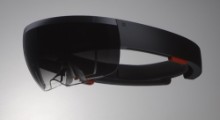
A roomful of reporters chase invisible balls around a cold San Francisco hotel conference room. Some are crawling on their knees, others shouting "Reset balls!" and wiggling their fingers at no one in particular.
It's not a mass hallucination but part on a hands-on demo of Microsoft's new augmented-reality headset, the HoloLens. The unreleased device overlays 3D virtual objects (in this case, falling origami balls) on top of your real surroundings.
 |
The Redmond, Wash.,-based company brought 100 of the goggles to its Build developers' conference last week to give attendees a taste of what it's like to make "holographic" programs. It was also a chance for Microsoft to recast itself as a tech company of the future instead of one stuck in the past.
'Microsoft Edge' will replace Internet Explorer
Microsoft (MSFT) is the latest major tech player to gamble on unproven, innovative hardware. Google (GOOG) had the (now mostly defunct) Google Glass. Apple (AAPL) spent the past seven months breathlessly building up the Apple Watch.
HoloLens is the computing platform of the future, according to Microsoft, and it has potential for more than just games.
It could be used to remotely guide someone through home repairs, with an expert annotating your real broken washing machine with virtual arrows and circles. Medical students could practice removing virtual appendixes from holo-cadavers. Architects could walk through a fully realized blueprint at an empty building site.
And according to one useless but delightful example shown during the Build keynote, HoloLens could even give you a virtual dog.
Hands on with Microsoft's HoloLens
Microsoft has made a lot of progress on the device since it first unveiled the technology in January. Those demo models were rough, covered in exposed wires and bore little resemblance to the sleek concept device shown on stage. The latest model is is a shiny black wrap-around visor with a strap that secures it to your head.
HoloLens is still in beta and has its bumps -- the field of view is narrow and the headset a bit heavy to wear for extended periods of time. It's far from being the experience shown in Microsoft's promo videos. But the spacial sound, eye tracking, and mapping features are incredible. In close to real time, HoloLens can figure out what's in front of it and seamlessly integrate 3D designs with physical objects.
For the final demonstration on Thursday, reporters dropped an origami ball by staring at it and speaking voice commands. It exploded and blew a holographic hole in a real table, exposing an expansive illustrated underworld with green hills, rivers, and folded cranes lazily flying through the blue sky.
Even if it never makes it out of the lab, HoloLens could end up as a success for the 40-year-old company. The hardware and software shows Microsoft's imaginative, youthful, risk-taking side. It got a roomful of normally jaded people to feel a bit of wonder and excitement.
Let's see the Start button pull that off.

